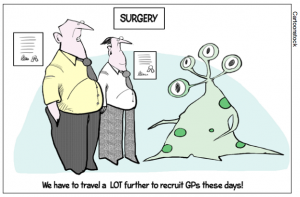It is common for patients to have to wait over a week and in some cases much longer for a routine appointment with a GP. Most surgeries run a system for same day appointments, but these slots go quickly, sometimes only minutes after surgeries open.
Waits have increased over the past few years. In the report – NHS Pressure – Winter Crisis 2018/19 – the BMA found that the number of patients waiting over two weeks for an appointment with their GP was up by 13% compared to the same months in 2018. Appointments with a wait of over 28 days were up 15% on the previous year rising to 2,230,000.
Social media has shown instances of patients queuing outside surgeries before they open in order to get appointments. With one person reporting that patients in Wellingborough were queuing 75 minutes before surgery opening time.
Why is this happening?
The simple answer is there are not enough GPs. Despite a government promise in 2015 of 5,000 more GPs, data from NHS Digital released in April 2019 shows that there has been a 4% fall in full-time equivalent (FTE) GP numbers between September 2015 and September 2018; there are now 1,180 fewer GPs than three years ago.
A longer term look at GP numbers by The Nuffield Trust concluded that there had been a “recent sustained fall” in GP numbers relative to the size of the UK population. This is something that has not happened since the 1960s.
- Support our NHS campaigning journalism
- SIGN UP to receive our articles >>>
The fall in GP numbers comes at a time of population growth, according to The Health Foundation, with the number of people registering with GPs up 3% over the past three years. As a result the number of patients per GP has risen by 8%.
Does the situation vary across the country?
Some areas of England are having more trouble than others recruiting and retaining GPs, with areas considered to be deprived or very isolated from large cities having the most difficulties.
Between 2008 and 2017, the number of GPs working in the most deprived 20% of areas fell by 511, in contrast to the wealthiest 20% where 134 additional GPs were recruited. As a result, these areas often have the worst waiting times for appointments.
Nuffield Trust figures for 2018 found that England fared the worst of the four nations, with 58 GPs per 100,000 population, and within England regional differences were marked, with the East of England and North West London having the lowest levels of 54 per 100,000.
The Nuffield Trust also shows that there are significantly fewer GPs per head of population in the more deprived areas of England than in the richer areas. In the most deprived fifth of CCG areas there are 47 GPs per 100,000 people, compared to 53 GPs per 100,000 population in the least deprived fifth of CCG areas.
One notable area is Swale in Kent, a deprived area, where in 2018 one surgery in Shepway had just one GP per 4,196 patients registered and another had one GP per 3,847 registered patients. As a result of these low GP numbers, patients in deprived areas find it harder to get a GP appointment and have a poorer experience of primary care.
Even in the much more affluent area of Oxfordshire, GP shortages are hitting patients. The Oxford Mail reported that in March 2019 more than 13,900 patients had to wait longer that four weeks for a GP appointment in the area. The CCG area is reported to be 21 GPs short.
Why is the number of GPs falling?
The fall in the number of GPs in England is due to a combination of factors, including: a lack of junior doctors entering training to become GPs; a rise in the number of trained GPs leaving the NHS, either to work abroad or taking early retirement; and a rise in the number of GPs choosing to work part-time.
Surveys of GPs have found that the primary reason given by GPs for leaving the NHS, including retiring early, is increasing workload, including administration.
In 2014, a study on GP morale and future plans found that one in five GPs intended to retire within the next five years.
A follow–up study in 2018 published in BMJOpen found that morale had reduced further over the preceding years and almost half had brought forward their plans to leave general practice. The most common reasons given for leaving sooner than previously planned were work intensity and workload.
The heavy workload of GPs is impacting on their health and as a result more and more are planning to either quit the NHS or go part-time.

How many GPs do we need?
The report by the King’s Fund, The Health Foundation and the Nuffield Trust, Closing the Gap, noted that the NHS will be 7,000 GPs down in five years time if the current trend continues, despite an increase in training places for GPs.
With the regional discrepancies, however, this will mean that some areas, will feel this shortfall much sooner than others; GP Online confirmed that GP numbers are falling fastest in the most deprived areas.
What is being done to increase the number of GPs?
In 2015, the government promised 5,000 more GPs by 2020. The main target for NHS England has been an increase in training and recruitment of GPs from abroad.
In 2016, the golden hello was introduced for trainee GPs who applied for places in certain areas, that found it difficult to attract trainees. The trainees were given a £20,000 payment for agreeing to stay for three years of training in the area. The 2018-19 scheme filled its 265 places.
There has also been an expansion of training places overall, with a record number entering training in 2018/19, according to NHS England.
NHS England is also recruiting GPs from abroad. The international recruitment scheme was launched in April 2016 with a target of 500 GPs by 2020. It was relaunched in August 2017 with an increased target of 2,000-3,000 GPs by 2020.
Are the incentives working?
The simple answer is no, the data published in April 2019 clearly shows that despite incentives from NHS England, there is no way the NHS is going to have 5,000 more GPs by 2020. In January 2019 the Health and Social Care Secretary admitted that the 2020 date was no longer a target, but failed to set a new target date.
In February 2019, CCGs involved in international recruitment process reported that they have had to cut their targets and NHS England admitted that only just over 70 GPs have been recruited so far and only 50 of these have entered the country. Despite this the scheme has been extended to 2023/24.
In May 2019, recruiters involved in the process, told Pulse that Brexit is putting off potential GPs, even those GPs seeking to return from Australia.
What does the future look like?
NHS England are hoping to ease the pressure by creating new collaborations to share GP work, with pharmacists and Physiotherapists and by grouping GPs into bigger practices. This strategy appears to acknowledge that the GP recruitment strategy is failing and puts new emphasis on attempting to manage demand through different ways of working.
Local GP practices are being asked to merge together in to Primary Care Networks serving 30-50000 patients each. They will keep their existing GMS contracts and their current relationship as part of the wider NHS network, but by agreeing to the change they will access new funding to take on seven new areas of work including; structured medication reviews, enhanced health in care homes, anticipatory care (with community services), and work on early cancer diagnosis.
The Kings Fund cites the fact that Wales, Scotland and Northern Ireland have already implemented similar models. “In Scotland, a key feature of the new GP contract has been the obligation to become part of a geographical quality cluster.” The think tank reports that these have generally worked well, except when covering a mix of urban and rural practices that face different issues.
However GP practice leaders are worried that the new structures mask a likely increase in workload, over 50% supported this view in a survey report by GP online. A concern which could well stem from the NHS long term plan, which has a headline goal to transfer more treatment out of hospital and into the community.
What should the Government be doing?
Health commentators are agreed on the urgent need for a well funding national workforce strategy, a document that, several months on from the NHS plan, has yet to be published.
The Government has chosen to target training and international recruitment, despite the overwhelming evidence that GP retention is a major problem.
At the moment, the numbers of doctors training to be GPs may have increased, but without changes to the working conditions, it is unlikely that enough will stay in the profession.
At present, primary care is in a vicious circle – as GPs leave and are not replaced working conditions for the remaining GPs get worse causing more to leave.
Manageable workloads, support for staff wellbeing and strategies to prevent dangerous stress are all needed to keep GPs working according to many GP organisations
In May 2019, the Royal College of GPs published Fit for the Future – in 3,000 GPs talk about what will make a difference. This included an end to the 10 minute appointment, with patients able to have 15 minute or longer appointments, improvements in continuity of care and an end to isolated working.
For the college’s vision of the future to work, the report states that changes will have to be made, including: “general practice receives at least 11% of the NHS budget in all four nations of the UK; the full-time equivalent GP workforce expands by thousands, as does the wider practice team workforce; and that GP specialty training is extended to at least four years to expose trainees to the full breadth of skills and conditions they are likely to need and see in general practice.”
Dear Reader,
If you like our content please support our campaigning journalism to protect health care for all.
Our goal is to inform people, hold our politicians to account and help to build change through evidence based ideas.
Everyone should have access to comprehensive healthcare, but our NHS needs support. You can help us to continue to counter bad policy, battle neglect of the NHS and correct dangerous mis-infomation.
Supporters of the NHS are crucial in sustaining our health service and with your help we will be able to engage more people in securing its future.
Please donate to help support our campaigning NHS research and journalism.


